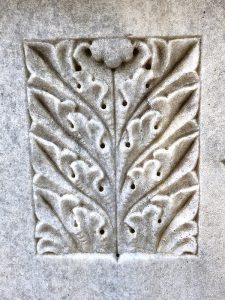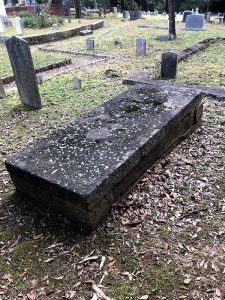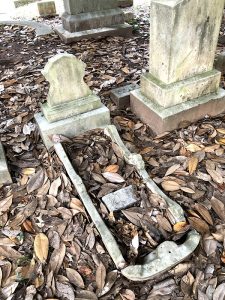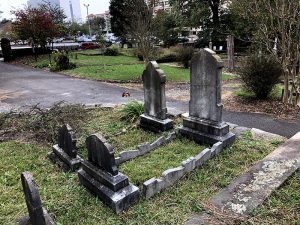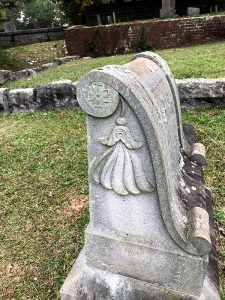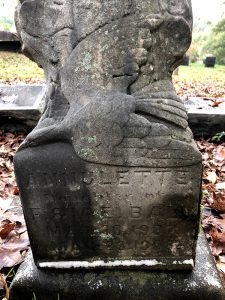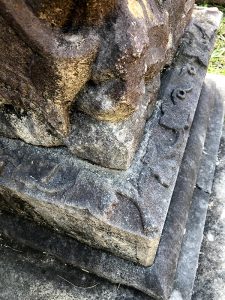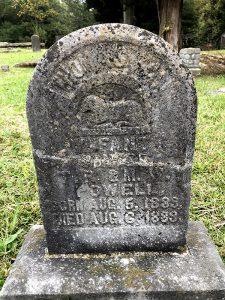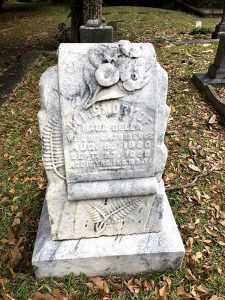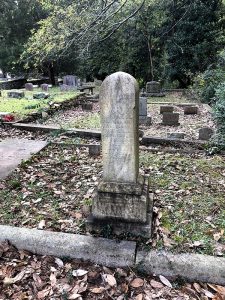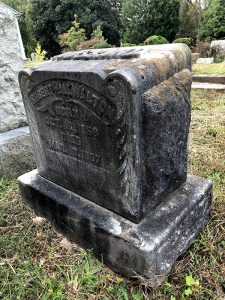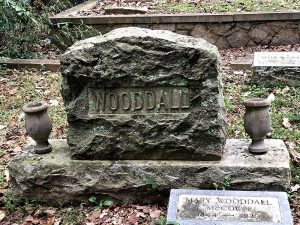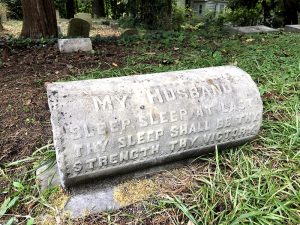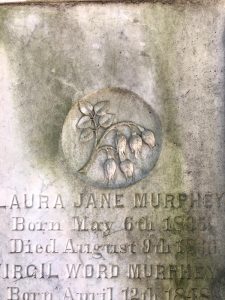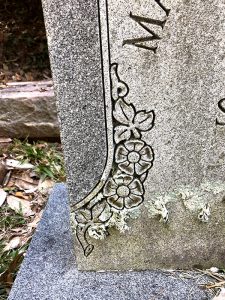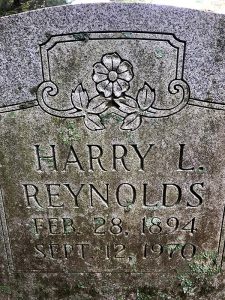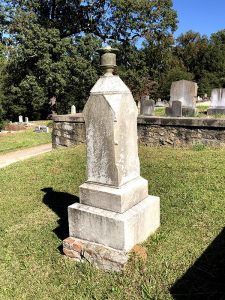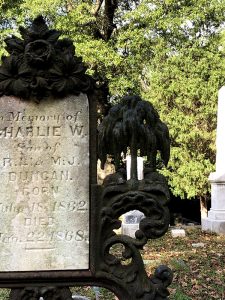Decatur Cemetery Symbols – A Visual Guide
Decatur Cemetery Symbols-Learn how to identify the religious, natural, and decorative symbols in historic cemeteries, like Decatur Cemetery in Decatur, Georgia.
By Melissa Carlson, Executive Director
The oldest headstones in Decatur Cemetery date to 1827, but burials continue now throughout the entire cemetery. These photos are from the historic “Old Section” which includes about 7.5 acres while the entire cemetery is now 58 acres. Decatur was established as DeKalb County’s seat of government in 1823 and for decades it remained a small town. The modest nature of this beautiful cemetery does not detract from its serene beauty. Much has been written about the history of its occupants; links for additional information are found at the end of this photo essay.
Early American cemeteries seldom had any formal design and were often found at churches or on private land. The tombstones tended to have little symbolism or romantic language; they presented death in a straightforward manner. This began to change in the Victorian period, when cemeteries were treated more like parks and romanticism was used to comfort the living. While religious symbols were still used, natural imagery was also incorporated adding deeper context and additional sentiment about those who had passed away. The cemetery became a more peaceful place of contemplation with restful images bolstering the visitors’ emotions in the face of death. Each entry in this symbol guide has a primary focus, but you will see repeated themes on some of the more ornate or complex headstones. Keep in mind that symbols are also a personal experience; some meanings listed here may resonate with you, or you may find an image brings a different concept to mind.
Here are some of the common symbols found in historic cemeteries. Next time you visit the Decatur Cemetery – or any historic cemetery – you can ponder the meanings sent to you from spirits of the past.
Acanthus Leaf
This plant motif is often found in classical architecture. The thorny leaves of the acanthus can be thought of a symbol of the “prickly” journey from life to death, and ultimately the final triumph of eternal life.
Anchor

An anchor was used to signify safety, hope, and steadfastness. It could represent a sailor and was used by early Christians as a disguised cross.
Bible or Book
Books are often found on headstones and are most commonly bibles. On open version may suggest the Book of Life, while a closed book may indicate the completion of a life’s story.
Box Tomb
Calla Lily
The calla lily is often used to represent marriage, resurrection, and majestic beauty. The top image is from a Woodman of the World headstone. The bottom two examples show the calla lilies displayed in classical vases and are for a husband and wife from different families.
Chain – Three Links

This image was almost imperceptible on this worn headstone. This is the symbol of the Independent Order of Odd Fellows. Because of this widely used symbol Odd Fellows have become known as “The Three Link Fraternity.” The three links represent friendship, love and truth, which is sometimes also represented by using the initials “F L T” within the links.
Chain – Broken
Child’s Booties

A straightforward and poignant symbol of the loss of a beloved child.
Classical motifs
Many classical architectural motifs are used in funerary art. Some of these are explored individually in this guide, like the acanthus leaf, urn, and laurel wreath. Here are three grave markers that exhibit hallmarks of the neoclassical architectural style in America. A detail from a larger monument focuses an urn and egg and dart molding.
Cradle Graves
Cross & Crown
The Christian symbol of a cross inside a crown can represent suffering (the cross) followed by eternal reward (the crown) and a triumph over death.
Cross- Religious Symbols
Crosses are well-represented in Christian cemeteries and appear in many different styles and designs. They are a symbol of both Christ and the Christian faith. Oftentimes large crosses are placed as a monument for an entire family plot. Another common way a visitor will see one is on a military marker. Here are just a few of the crosses in Decatur Cemetery – from the large to the small.
Cypress Trees
Dogwood Blossom Flowers
Dogwood flowers can symbolize strength, purity, resilience, and rebirth. Some Christians believe that it was dogwood that was used in the cross on which Jesus Christ was crucified. The four petals are said to represent the cross, while the pink tips signify the nails of the cross. The center of the flower also represents the crown of thorns.
Dove Bird
Doves are a traditional symbol of innocence, love, peace, and hope. For Christians, the dove may also represent resurrection, the Holy Spirit, or the safe transport of the soul to heaven.
Drapes, Palls, Veils, and Tassels
These nearly synonymous symbols became very popular to represent mourning and can be found on small headstones, monuments, obelisks, and urns. A pall is simply the cloth that is laid on a coffin or tomb. A veil can be considered to be a partition between the living and the spirit realm. And draperies and tassels come from the Victorian era custom of covering the visitation rooms of homes or funeral parlors in decorative heavy black cloth. All of these also bring to mind a shroud which would have been placed over a body. Carved here in stone, these draperies serve as a sign of loss and morning.
Fern
Ferns are used to refer to eternal youth or a person’s humility and sincerity.
The Gates of Heaven
Symbolizing the entrance to heaven, they are shown open. The gates are a passageway to the afterlife and some believe departed souls are able to pass back and forth between Heaven and earth. In this way you are connected to your loved ones who may return to watch over you.
Grapes

Grapes symbolize the blood of Christ.
Hand Pointing Up
A hand pointing up refers to the hope of heaven or a soul’s ascent to heaven.
Inverted Torches
A lit torch represents life and immortality while an extinguished torch represents death. These inverted torches, which are still lit, represent death and the passing of the soul into the next life. The flame may remain to guide the soul on their journey.
Ivy
Ivy carved onto a tombstone can represent friendship, fidelity and immortality.
Lamb- Animal
The lamb was often used for children as a symbol of the innocence and purity of those who had passed. However, there are two examples here for a Mother and Father. It is unfortunate that several of the statues are missing their heads.
Laurel Wreath- Flower

The laurel is an evergreen plant; as a wreath it represents victory, distinction, eternity or immortality.
Lily Flower
The lily represents innocence, purity, renewal, and the resurrection of Christ. In other faiths, it has been associated with the divine feminine and was sacred to Hera, Queen of Heaven (Greece). It also has a strong association with the chastity of the Virgin Mary.
Lyre- Musical Instrument

A Greek lyre is a string instrument symbolizing wisdom, moderation, heaven, and peace. It can also represent the journey from this world to the underworld.
Monument
In this cemetery, a monument is a structure erected to commemorate a person or family. These are larger or more complex than ordinary headstones but do not include obelisks which are listed separately. These generally have a great deal of symbolism and/or text to commemorate the deceased.
Morning Glory Flower
The morning glory represents the mortality of life.
Oak Tree & Acorns

With symbolism dating back to ancient times, the leaves and acorns of an oak tree represent longevity, strength, power, honor, prosperity, and triumph.
Obelisk
An obelisk is usually a four-sided stone shaft with a pyramid shaped point at the top. They can vary in height and have a long history as grave markers. Obelisks were first used at Egyptian temples and later appeared in the mortuary complexes of pharaohs. They became a popular form of cemetery art in the United States by the 1840s and continued to be used until about the 1920s. There are several covered, or draped, obelisks also shown in the “Drapes” section.
Organizational Affiliations Symbols
Symbols on headstones often represent concepts resonant with one’s faith. But they are also a place to show symbols from organizations important to the deceased. Examples seen in the Decatur Cemetery include the Shriners, Masons, Woodmen of the World, and the Order of the Eastern Star.
“Natural” Stone
Although they were carved to achieve this look, these rustic markers were made to appear more natural in their settings.
Pillow
There are at least three of these unusual grave markers in Decatur that look like bolster pillows and are meant to convey a peaceful eternal rest. However, one is actually a draped log.
Rose Flower
Nearly every type of flower can be found on a headstone, but none seem as popular as the rose, which symbolizes love, beauty, and virtue. As a popular funeral flower, their deep fragrance can also be evocative of piercing sorrow. Rose buds, or broken stems, are often used to represent a child’s life cut short. Sometimes, the fuller the rose bloom is depicted, the longer the person has lived.
Sphinx
The sphinx was a popular motif from the Egyptian Revival style of architecture (here from the 1920s) and is guarding this family plot, They are representative of courage, power, and honor.
Tree Trunks & Logs
Another unusual type of headstone came from the fraternal organization know as Woodmen of the World. A tombstone in the shape of a tree trunk is symbolic of the brevity of life. Some of these headstones do not seem to be from W.O.W., but have a folk art quality which combines the natural world with the transition of death.
Urn
Urns have a long association with death and the memorialization of life. They were used to hold the remaining ashes after a cremation, but that is not an accepted burial practice in some faiths. So even when cremation was not used, the empty urn was symbolic of immortality and is meant to represent the soul. They are also found draped, as shown earlier in this article.
Weeping Willow Tree
The drooping branches of the tree are a visual representation of sorrow, or mourning.
Additional resources for the Decatur Cemetery:
https://www.visitdecaturgeorgia.com/publicworks/page/cemetery
https://www.decaturga.com/publicworks/page/friends-decatur-cemetery
https://www.atl2020.net/decatur-cemetery.html


